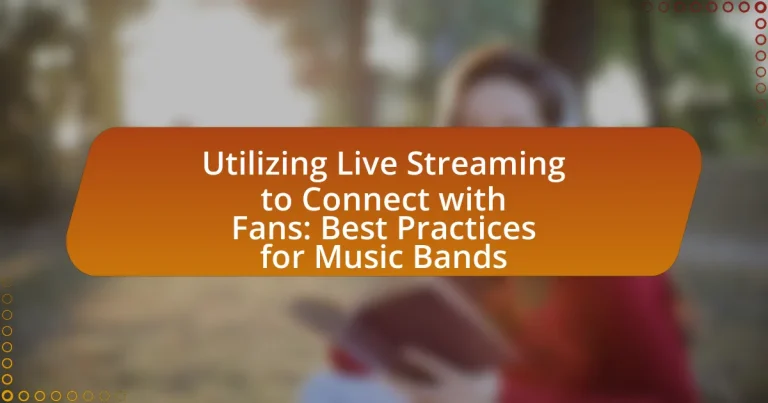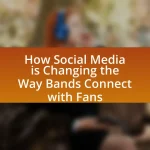Live streaming for music bands is a method of broadcasting live performances over the internet, enabling real-time fan engagement and interaction. This article explores the significance of live streaming in the music industry, highlighting its potential to expand audience reach, enhance fan loyalty, and create new revenue streams through ticket sales and merchandise. Key topics include popular streaming platforms, essential technology for effective streaming, strategies for engaging with fans, and best practices for overcoming common challenges. Additionally, the article provides insights into optimizing audio and video quality, promoting live events, and ensuring a successful streaming experience.
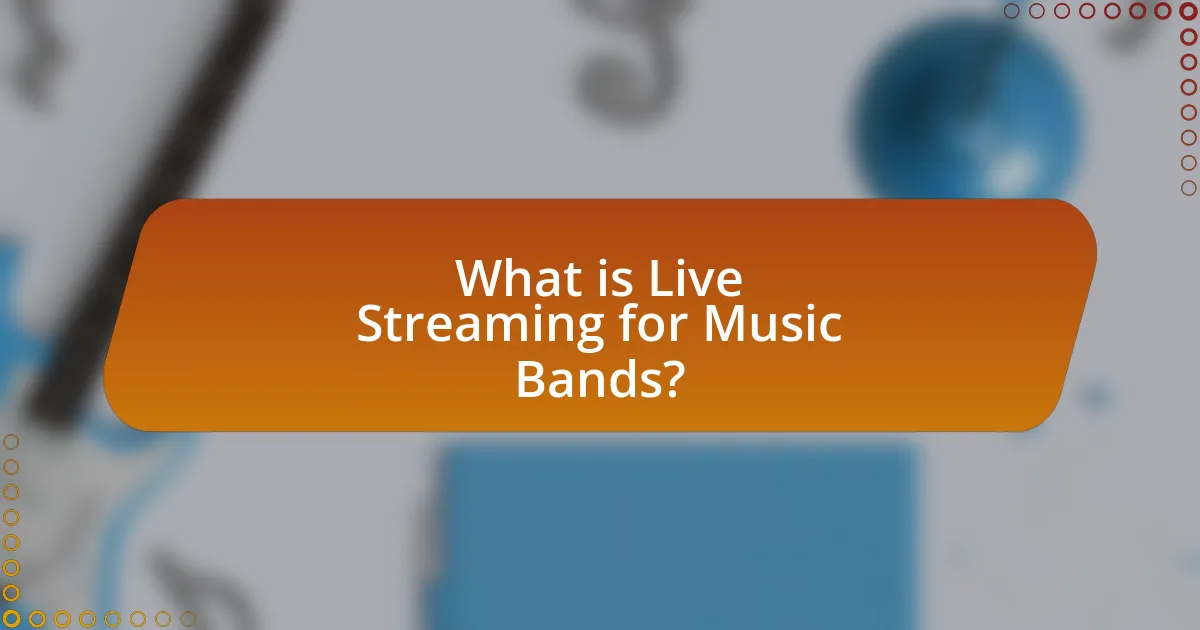
What is Live Streaming for Music Bands?
Live streaming for music bands is the process of broadcasting live performances over the internet, allowing fans to watch in real-time from anywhere. This method has gained popularity due to its ability to reach a wider audience, especially during events where physical attendance is limited, such as during the COVID-19 pandemic. According to a report by Statista, the global live streaming market is expected to reach $247 billion by 2027, highlighting its growing significance in the music industry. Live streaming not only enhances fan engagement but also provides bands with new revenue streams through ticket sales, merchandise, and sponsorships.
How does live streaming work for connecting with fans?
Live streaming connects music bands with fans by allowing real-time interaction and engagement through video broadcasts. This format enables bands to perform live, share behind-the-scenes content, and respond to fan comments instantly, fostering a sense of community. According to a report by Statista, 82% of viewers prefer live video over social posts, highlighting the effectiveness of live streaming in enhancing fan connection. Additionally, platforms like Twitch and YouTube Live provide tools for monetization and audience analytics, further solidifying the relationship between artists and their fans.
What platforms are most popular for live streaming music events?
The most popular platforms for live streaming music events are YouTube, Facebook Live, Instagram Live, Twitch, and TikTok. YouTube is widely recognized for its extensive reach and user base, hosting numerous live music events and concerts. Facebook Live allows artists to engage with fans directly, while Instagram Live offers a more personal connection through real-time interactions. Twitch, originally a gaming platform, has gained traction in the music industry, providing a space for artists to perform and interact with audiences. TikTok has also emerged as a significant platform for music promotion and live performances, leveraging its viral nature to reach younger audiences. These platforms collectively facilitate artist-fan connections and enhance the live music experience.
What technology is required for effective live streaming?
Effective live streaming requires a combination of high-quality cameras, reliable internet connection, audio equipment, and streaming software. High-definition cameras capture clear video, while a stable internet connection ensures smooth transmission without interruptions. Professional audio equipment, such as microphones and mixers, enhances sound quality, making the experience more engaging for viewers. Streaming software, like OBS Studio or Streamlabs, facilitates the integration of video and audio sources, enabling real-time interaction and customization. These technologies collectively contribute to a professional and engaging live streaming experience for music bands connecting with their fans.
Why is live streaming important for music bands?
Live streaming is important for music bands because it allows them to reach a wider audience and engage with fans in real-time. This method of performance enables bands to perform live concerts to viewers who may not be able to attend in person, thus expanding their fan base. According to a report by Statista, 67% of live stream viewers are more likely to purchase tickets to a concert after watching a live stream of the artist. Additionally, live streaming provides an interactive platform where fans can comment and engage during performances, fostering a sense of community and connection. This direct interaction can enhance fan loyalty and increase merchandise sales, making live streaming a crucial tool for modern music bands.
How does live streaming enhance fan engagement?
Live streaming enhances fan engagement by providing real-time interaction and immersive experiences. This format allows fans to participate in events as they happen, fostering a sense of community and connection. For instance, platforms like Twitch and YouTube Live enable artists to engage directly with their audience through live chats, Q&A sessions, and instant feedback, which can increase viewer loyalty and investment in the artist’s brand. According to a study by the Interactive Advertising Bureau, 63% of viewers reported feeling more connected to a brand after watching a live stream, demonstrating the effectiveness of this medium in building fan relationships.
What are the potential revenue streams from live streaming?
Potential revenue streams from live streaming include ticket sales, merchandise sales, sponsorships, donations, and subscription models. Ticket sales generate direct income from viewers purchasing access to live events, while merchandise sales capitalize on fan engagement during streams. Sponsorships involve brands paying for advertising or promotional opportunities during the live stream, enhancing revenue. Donations from fans, often facilitated through platforms like Patreon or direct tipping, provide additional financial support. Lastly, subscription models, where fans pay a recurring fee for exclusive content or experiences, create a steady income stream. These revenue streams are increasingly vital for music bands to sustain their operations and connect with their audience effectively.
What challenges do music bands face with live streaming?
Music bands face several challenges with live streaming, including technical issues, audience engagement, and monetization difficulties. Technical issues often arise from unreliable internet connections, inadequate equipment, or software glitches, which can disrupt the streaming experience. Audience engagement is another significant challenge, as bands must find ways to interact with viewers virtually, which differs from the immediate feedback received in live performances. Additionally, monetization can be problematic, as bands may struggle to generate revenue through streaming platforms compared to traditional live shows, where ticket sales and merchandise contribute significantly to income. These challenges highlight the complexities of adapting to a digital performance environment while maintaining a connection with fans.
How can technical issues impact a live streaming event?
Technical issues can significantly disrupt a live streaming event by causing interruptions, reducing audio and video quality, and leading to viewer disengagement. For instance, a study by Livestream and New York Magazine found that 67% of viewers reported abandoning a live stream due to buffering or poor quality. These disruptions can result in a loss of audience engagement, negatively affecting the band’s ability to connect with fans and potentially harming their reputation. Additionally, technical failures can lead to missed opportunities for real-time interaction, such as Q&A sessions or live chats, which are crucial for fan engagement during a streaming event.
What are common pitfalls to avoid during a live stream?
Common pitfalls to avoid during a live stream include poor internet connectivity, lack of preparation, and ignoring audience engagement. Poor internet connectivity can lead to buffering and interruptions, which disrupts the viewing experience. Lack of preparation, such as not having a clear agenda or rehearsing content, can result in a disorganized stream that fails to engage viewers. Ignoring audience engagement, like not responding to comments or questions, can make fans feel undervalued and less likely to return for future streams. These pitfalls can significantly diminish the effectiveness of live streaming as a tool for connecting with fans.
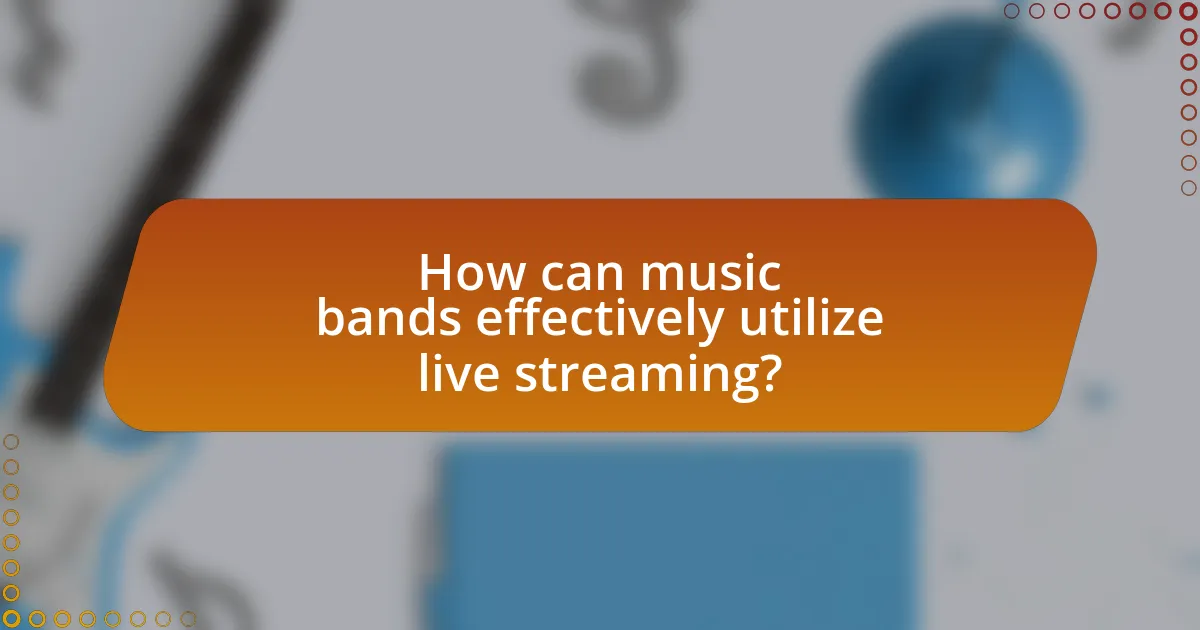
How can music bands effectively utilize live streaming?
Music bands can effectively utilize live streaming by engaging with their audience through interactive performances and exclusive content. By using platforms like YouTube Live, Twitch, or Instagram Live, bands can reach a global audience, allowing fans to participate in real-time through comments and reactions. This interaction fosters a sense of community and connection, which is crucial for fan loyalty.
Additionally, bands can offer behind-the-scenes access, virtual meet-and-greets, and Q&A sessions, enhancing the fan experience. According to a report by Midia Research, 60% of fans prefer live streaming events over traditional concerts due to the accessibility and convenience they provide. This statistic underscores the importance of live streaming as a tool for bands to maintain and grow their fanbase in a digital-first world.
What strategies can bands implement for successful live streaming?
Bands can implement several strategies for successful live streaming, including engaging with their audience through interactive features, promoting the event across multiple platforms, and ensuring high-quality audio and video production. Engaging with the audience can be achieved by incorporating live chats, Q&A sessions, or polls during the stream, which fosters a sense of community and connection. Promoting the event on social media, email newsletters, and band websites increases visibility and attendance, as evidenced by a 2021 study showing that 70% of viewers discover live streams through social media. High-quality audio and video production is crucial, as poor quality can lead to viewer disengagement; research indicates that 85% of viewers abandon streams due to audio issues. By focusing on these strategies, bands can enhance their live streaming experiences and strengthen their connection with fans.
How can bands promote their live streaming events?
Bands can promote their live streaming events by leveraging social media platforms, email newsletters, and collaborations with influencers. Social media allows bands to reach a wide audience quickly; for instance, platforms like Instagram and Facebook can be used to create event pages and share countdowns, generating excitement. Email newsletters can inform dedicated fans about upcoming streams, providing direct links and exclusive content. Collaborating with influencers or other artists can expand reach, as their followers may also tune in. According to a study by Eventbrite, 80% of event organizers found social media to be the most effective promotional tool, highlighting its importance in driving attendance.
What role does audience interaction play during live streams?
Audience interaction plays a crucial role during live streams by enhancing viewer engagement and fostering a sense of community. This interaction allows fans to participate actively, influencing the content and direction of the stream, which can lead to increased viewer retention and satisfaction. Research indicates that streams with high levels of audience interaction, such as live chats and polls, can boost viewer engagement metrics significantly, with studies showing that interactive elements can increase viewer retention rates by up to 30%. This dynamic not only enriches the viewing experience but also strengthens the connection between music bands and their fans, making the live streaming experience more memorable and impactful.
What types of content work best for live streaming?
Engaging and interactive content works best for live streaming, particularly in the context of music bands. This includes live performances, Q&A sessions, behind-the-scenes footage, and interactive fan engagement activities. According to a study by Livestream and New York Magazine, 80% of audiences prefer live video over traditional social media posts, indicating a strong preference for real-time interaction and authenticity. Additionally, live performances allow bands to showcase their music in an immediate and dynamic way, fostering a deeper connection with fans.
How can bands incorporate behind-the-scenes content into their streams?
Bands can incorporate behind-the-scenes content into their streams by sharing exclusive footage of rehearsals, songwriting sessions, and personal interactions among band members. This approach fosters a deeper connection with fans, as it provides insight into the creative process and the personalities behind the music. For instance, platforms like Instagram Live and Twitch allow bands to engage with their audience in real-time, showcasing candid moments that highlight their authenticity. Research indicates that fans are more likely to feel a sense of loyalty and connection when they perceive artists as relatable and transparent, which is achieved through such behind-the-scenes content.
What are the benefits of hosting Q&A sessions during live streams?
Hosting Q&A sessions during live streams enhances audience engagement and fosters a sense of community. These sessions allow fans to interact directly with artists, creating a personal connection that can lead to increased loyalty and support. Research indicates that interactive content, such as Q&A sessions, can boost viewer retention rates by up to 80%, as audiences are more likely to stay engaged when they feel their questions are being addressed. Additionally, Q&A sessions provide valuable feedback for artists, enabling them to understand fan preferences and interests better, which can inform future content and marketing strategies.
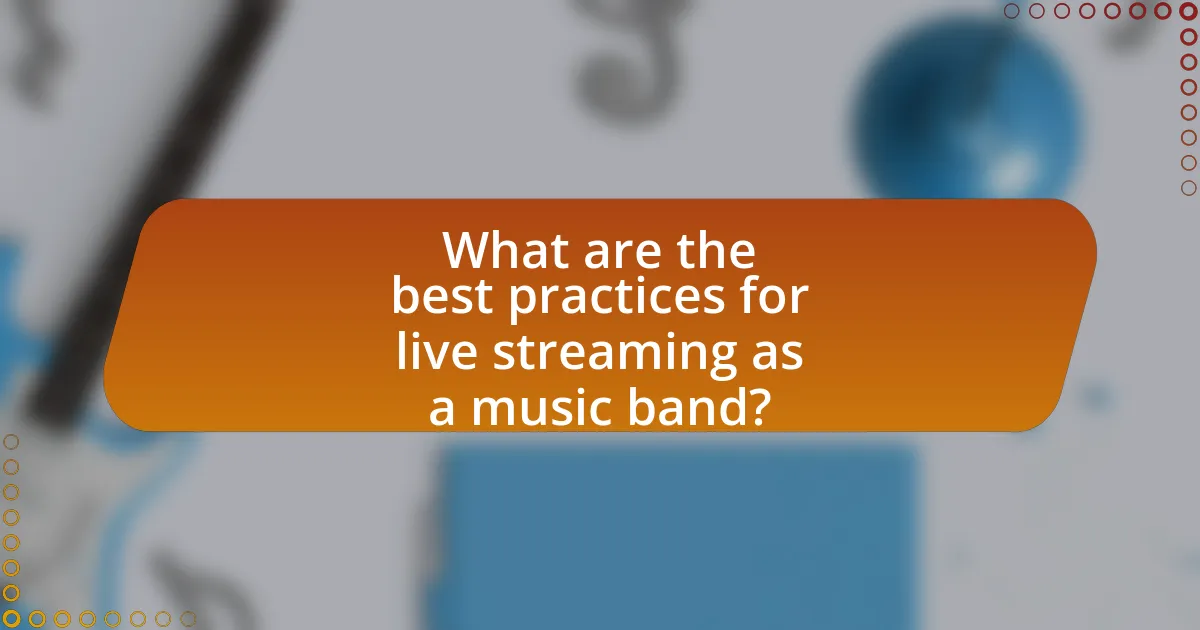
What are the best practices for live streaming as a music band?
The best practices for live streaming as a music band include ensuring high-quality audio and video, engaging with the audience, promoting the stream in advance, and utilizing interactive features. High-quality audio is crucial because poor sound can detract from the performance; studies show that 70% of viewers prioritize audio quality in live streams. Engaging with the audience through live chat or Q&A sessions fosters a sense of community and connection, which is essential for fan loyalty. Promoting the stream across social media platforms increases visibility and attendance, as research indicates that pre-event marketing can boost viewer numbers by up to 50%. Lastly, using interactive features like polls or requests enhances viewer participation, making the experience more memorable.
How can bands ensure high-quality audio and video during streams?
Bands can ensure high-quality audio and video during streams by investing in professional-grade equipment and optimizing their internet connection. High-quality microphones and cameras significantly enhance sound and visual clarity, while a stable, high-speed internet connection minimizes lag and buffering, which are critical for live performances. According to a study by the International Telecommunication Union, a minimum upload speed of 5 Mbps is recommended for streaming high-definition video, ensuring a smooth experience for viewers. Additionally, using audio interfaces and mixers allows for better sound control, further improving the overall quality of the stream.
What equipment is essential for achieving professional-quality streams?
To achieve professional-quality streams, essential equipment includes a high-definition camera, a quality microphone, and a reliable streaming platform. A high-definition camera, such as a DSLR or mirrorless camera, ensures clear video quality, which is crucial for engaging viewers. A quality microphone, like a condenser or dynamic microphone, captures clear audio, enhancing the overall experience for the audience. Additionally, using a reliable streaming platform, such as OBS Studio or Streamlabs, allows for seamless broadcasting and integration of various media sources. These components collectively contribute to a polished and professional streaming presentation, which is vital for music bands aiming to connect with fans effectively.
How can bands optimize their internet connection for streaming?
Bands can optimize their internet connection for streaming by using a wired Ethernet connection instead of Wi-Fi, which provides a more stable and faster connection. A wired connection reduces latency and minimizes interruptions, ensuring a smoother streaming experience. Additionally, bands should test their internet speed using tools like Speedtest.net to confirm they meet the recommended upload speed of at least 3 Mbps for standard streaming and higher for HD quality. Furthermore, limiting the number of devices connected to the network during streaming can prevent bandwidth congestion, enhancing overall performance.
What are effective ways to engage with fans during a live stream?
Effective ways to engage with fans during a live stream include interactive Q&A sessions, real-time polls, and shout-outs to viewers. These methods foster a sense of community and involvement, encouraging fans to participate actively. For instance, a study by the Interactive Advertising Bureau found that 70% of viewers are more likely to engage with content that includes interactive elements. Additionally, responding to comments and questions in real-time enhances the personal connection between the artist and the audience, making fans feel valued and heard.
How can bands use chat features to interact with viewers?
Bands can use chat features to interact with viewers by engaging in real-time conversations during live streams. This interaction allows bands to respond to fan questions, acknowledge comments, and create a sense of community. For instance, platforms like YouTube and Twitch enable bands to host Q&A sessions, where fans can ask about song meanings or upcoming projects, fostering a deeper connection. Additionally, using polls or prompts in the chat can encourage viewer participation, making fans feel valued and involved in the performance. This approach not only enhances viewer experience but also strengthens fan loyalty, as evidenced by increased engagement metrics reported by bands utilizing these features effectively.
What incentives can bands offer to encourage fan participation?
Bands can offer exclusive content, merchandise discounts, and interactive experiences as incentives to encourage fan participation. Exclusive content, such as behind-the-scenes footage or early access to new songs, creates a sense of belonging among fans. Merchandise discounts can incentivize purchases while fostering loyalty, as seen in successful campaigns where bands offer limited-time discounts during live streams. Interactive experiences, like Q&A sessions or live polls during performances, engage fans directly, enhancing their connection to the band. These strategies have been proven effective in increasing fan engagement and participation in various music industry studies.
What are some common troubleshooting tips for live streaming?
Common troubleshooting tips for live streaming include checking your internet connection, ensuring your streaming software is updated, and verifying that all audio and video sources are correctly configured. A stable internet connection is crucial; a minimum upload speed of 3 Mbps is recommended for standard quality streaming. Keeping your streaming software updated prevents compatibility issues, while proper configuration of audio and video sources ensures that your audience receives clear content. Additionally, testing your stream before going live can help identify potential issues, allowing for adjustments to be made in advance.
How can bands prepare for unexpected technical difficulties?
Bands can prepare for unexpected technical difficulties by conducting thorough pre-show sound checks and having backup equipment readily available. Sound checks allow bands to identify potential issues with audio equipment, ensuring that all components function correctly before the performance. Additionally, having spare microphones, cables, and other essential gear can mitigate the impact of technical failures during a live stream. According to a survey by the National Association of Music Merchants, 70% of musicians reported that having backup equipment significantly reduced performance anxiety related to technical issues. This preparation not only enhances the quality of the live stream but also ensures a smoother experience for both the band and their audience.
What steps should be taken if a stream experiences interruptions?
If a stream experiences interruptions, the first step is to assess the cause of the disruption, which may include checking internet connectivity, hardware functionality, or software settings. Following this assessment, the next step is to communicate with the audience about the issue, providing updates on the situation to maintain engagement. After addressing the immediate concerns, it is essential to troubleshoot the problem, which may involve restarting the streaming software, resetting the hardware, or switching to a backup internet connection. Finally, once the stream is restored, a recap of the interrupted content should be provided to ensure that viewers do not miss critical information. These steps are crucial for maintaining a professional streaming experience and keeping the audience informed and engaged.
